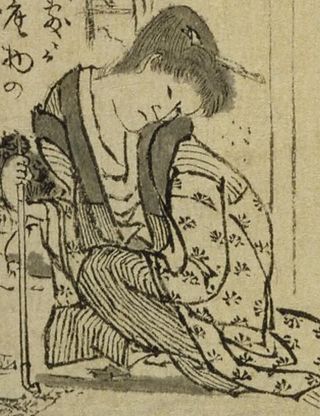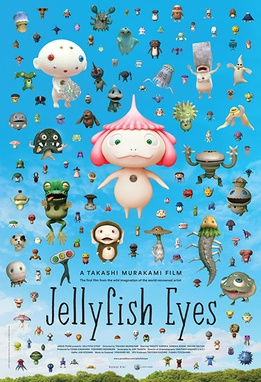
Machiko Hasegawa was a Japanese manga artist and one of the first female manga artists. She started her own comic strip, Sazae-san, in 1946. It reached national circulation via the Asahi Shimbun in 1949, and ran daily until Hasegawa decided to retire in February 1974. All of her comics were printed in Japan in digest comics; by the mid-1990s, Hasegawa's estate had sold over 60 million copies in Japan alone.
James Jean is a Taiwanese-American visual artist working primarily in painting and drawing. He lives and works in Los Angeles, where he moved from New York in 2003.

Superflat is a postmodern art movement, founded by the artist Takashi Murakami, which is influenced by manga and anime. However, superflat does not have an explicit definition because Takashi Murakami does not want to limit the movement, but rather leave room for it to grow and evolve over time.

Takashi Murakami is a Japanese contemporary artist. He works in fine arts as well as commercial media and is known for blurring the line between high and low arts. His influential work draws from the aesthetic characteristics of the Japanese artistic tradition and the nature of postwar Japanese culture. He designed the album covers for Kanye West's third studio album Graduation and West and Kid Cudi’s collaborative studio album Kids See Ghosts.

Yoshitomo Nara is a Japanese artist. He lives and works in Nasushiobara, Tochigi Prefecture, though his artwork has been exhibited worldwide. Nara has had nearly 40 solo exhibitions since 1984. His art work has been housed at the MoMA and the Los Angeles County Museum of Art (LACMA). His most well-known and repeated subjects are "big-headed girls" with piercing eyes, who one Nara scholar describes as having "childlike expressions [that] resonate with adult emotions, [their] embodiment of kawaii (cuteness) carries a dark humor, and any explicit cultural references are intertwined with personal memories."
Aya Takano is a Japanese painter, Superflat artist, manga artist, and science fiction essayist. Aya Takano is represented by Kaikai Kiki, the artistic production studio created in 2001 by Takashi Murakami.
Keiko Takemiya is a Japanese manga artist, professor and university administrator. As part of the Year 24 Group, she was a leading figure in shōjo manga scene in the 1970s creating such manga as Kaze to Ki no Uta, Toward the Terra, Natsu e no Tobira. Additionally she became head of the Faculty of Manga at Kyoto Seika University, and then later became the president of the university.
Bome is the pseudonym of a Japanese sculptor, primarily sculpting anime-styled women for mass commercial release. The name is a contraction of Baseball Cap and Eyeglasses, both of which he wears regularly. He started making garage kits and now works for Kaiyodo, a Japanese company that specialises in anime-related figurines. Bome's work has proved sufficiently popular and successful for Kaiyodo to release a Monsieur Bome Collection, including figures from such popular anime and video games as GunBuster, Full Metal Panic, Dead or Alive, Kiddy Grade, Xenosaga and Jingai Makyō. Bome has, amongst others, also sculpted characters from Neon Genesis Evangelion and Sailor Moon.
Hiromi Toshikawa, better known as Hiromix, is a Japanese photographer and artist.

Little Boy: The Arts of Japan's Exploding Subculture is the companion catalogue to the exhibition "Little Boy" curated by artist Takashi Murakami. The book is about the aesthetics of postwar culture in Japan and marks the final project of Murakami's Superflat Trilogy started in 2000.
Mr. is a Japanese contemporary artist, based in Saitama Prefecture, Japan. A former protégé of Takashi Murakami, Mr.'s work debuted in both solo and group exhibitions in 1996, and has since been seen in museum and gallery exhibitions in Tokyo, Osaka, Nagoya, Hong Kong, Seoul, Daegu, Paris, New York, Minneapolis, Chicago, Miami, Jerusalem, Los Angeles, and London.
Chiho is a feminine Japanese given name. The meaning differs based on the kanji used to write it; it may also be written solely in hiragana. Notable people with this name include:

Nakano Broadway (中野ブロードウェイ) is a shopping mall in Nakano, Tokyo. Founded in 1966 as a luxury shopping complex, it has become a popular destination for goods aimed at otaku.
SoFlo Superflat describes an art genre started in Miami in the 1990s. It is an urban pop art movement in South Florida that combines super bright colors and ultra flat images. The subject matters are very diverse. It is an outcrop of the Japanese Superflat movement, founded by the artist Takashi Murakami.

Katsushika Ōi, also known as Ei (栄) or Ei-jo, was a Japanese Ukiyo-e artist of the early 19th century Edo period. She was a daughter of Hokusai from his second wife. Ōi was an accomplished painter who also worked as a production assistant to her father.

Jellyfish Eyes is a 2013 Japanese fantasy film directed by contemporary artist Takashi Murakami. His debut feature film, it was released in Japan on April 26, 2013.

Erina Matsui is a Japanese contemporary artist. She is known for her surreal self-portraits, mostly done as oil paintings. Her work has been praised for its jarring visual impact as it defies normal representations of childhood being cute and innocent.
Six Hearts Princess, also known as 6HP, 6♡Princess, and Six♡Princess, is a magical girl anime television series created by Takashi Murakami with character designs by mebae. The first episode aired unfinished on Tokyo MX on December 30, 2016 and aired again in a finished state on September 29, 2017. 6 more episodes have aired sporadically over time as of September 2020. There are 15 episodes planned. The series' motifs are eight values matching the ones central to Nansō Satomi Hakkenden - Jin (benevolence), Gi (justice), Rei (politeness), Chi (wisdom), Chuu (loyalty), Shin (faith), Kou, and Tei (respect), the Kanji for which are included in the corresponding characters' surnames.
My Lonesome Cowboy is a sculpture created in 1998 by Japanese artist Takashi Murakami. Produced during Murakami's so-called "bodily fluids" period, the 9.45 ft-tall (288 cm) statue depicts an anime-inspired figure ejaculating a large strand of semen. Like its companion piece Hiropon, My Lonesome Cowboy is an example of superflat art, an art movement founded by Murakami in the 1990s to criticize Japanese consumer culture. The sculpture is noted as among Murakami's most famous works.
Hiropon is a sculpture created in 1997 by Japanese artist Takashi Murakami. Produced during Murakami's so-called "bodily fluids" period, the 7.33 ft tall statue depicts an anime-inspired figure expelling streams of breast milk from her nipples. Like its companion piece My Lonesome Cowboy, it is an example of superflat art, an art movement founded by Murakami in the 1990s to criticize Japanese consumer culture.









